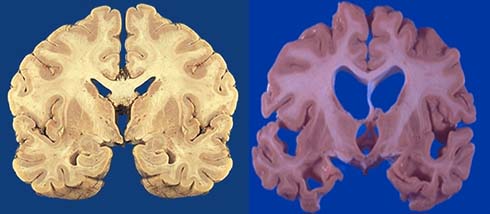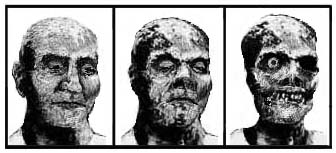The Science of Zombies
Part I
The Virus
 |
| Zombie plague spreaders: the Norway Rat and the tick (inset) |
As was the case with vampirism, humans infected with the virus would pass it from their saliva into the bloodstream of another through the bite.
Stages of the Disease
Stage One: Infection. Symptoms of zombie infection appear quickly: within one or two hours, the victim will develop a headache, fever, chills and other flu-like symptoms. Zombie infections last about half as long as their vampiric counterparts, mostly between three and six hours, during which the vaccine is 100 percent effective.
 |
| A zombie-bite victim under quarantine in Panama, 1905 |
Stage Three: Transformation. Zombies awaken from their comas in a catatonic state. They are unresponsive to most stimuli as they shuffle about, trying to locate their prey. Unlike vampires, there is no acclimation period; a zombie will begin hunting immediately upon transformation.
| |||||||
 |
| Cross-sections of a normal brain (l) and a zombie brain (r) show the extensive atrophy of zombie brain tissue |
"Follow your nose" might be the zombie motto. A zombie's powerful sense of smell compensates for the weakness of their other senses.
- Sight: due to degradation of their corneas, zombies suffer from severe myopia. In addition, they are colorblind.
- Hearing: zombies go deaf within a few weeks of transformation. Efforts to rehabilitate them through ASL training have thus far proved unsuccessful.
- Smell: zombies have even more receptor cells than vampires. If the wind is right, zombies can smell humans from as far as several miles away.
Circulatory System
As anybody who ever emptied his gun into an advancing zombie can tell you, zombies just don't bleed to death. Their circulatory adaptations allow them to survive wounds that would kill a human.
- Blood: zombie blood is thick and black, hence the nickname, "zombie oil."
- Heart: as with vampires, zombie blood is circulated by skeletal muscles rather than the heart.
Zombie core body temperature ranges between 65 and 75 degrees, making them slightly warmer than vampires. This is due to heat released by the various parasites living in zombie flesh, a phenomenon that causes zombies to emit steam in cool weather and phosporescence when in water.
Muscular/Skeletal System and Connective Tissue
Changes here are of good news-bad news variety. Yes, zombies are stiff-limbed and slow; yes they move along at a shuffle rather than a sprint. But they are also very powerful, with a
- Muscles/Connective Tissue: zombie muscle fibers become concentrated and take on the consistency of nylon rope. Ligaments and tendons thicken.

Normal jaw (l); Zombie jaw (r);
note the larger jawbone and
thicker muscle of the zombie jaw - Skeletal system: important modifications occur to the zombie jaw. Extra bone is deposited on the lower jaw to form an attachment point for larger chewing muscles. These adaptations enable zombies to bite through skull and bone and get at the pillars of their diet: brains and bone marrow.
- Teeth: zombie teeth are not adapted to the powerful forces exerted on them by the jaw. Teeth crack and fall out, and the holes they leave behind leak sludge-like zombie blood. Eventually, all their teeth are gone, and a zombie is forced to chew with its exposed jawbones.
- Hair: zombies who live long enough will lose all their hair.
- Skin: decay sets in shortly after transformation. The skin turns leathery, then rots away.
The great irony of zombie life is that even as they voraciously feed, they too are being fed upon. A zombie's body is like a big petri dish serving host to everything from bacteria and fungi to maggots and ants. The resulting state of putrefication means, as terrifying as a zombie may be to the eye, it actually commits far worse offenses to the nose.
A long-held, common misconception is that zombies are immortal. In fact, the vast majority of zombies live less than one year. It is possible to determine a zombie's age based on their external appearance; specifically, their level of decomposition, also known as necrotic degradation.
- Stage I: the skin is mottled and covered with open sores.
- Stage II: the ears and nose are rotting away. Loss of fingers and toes.
- Stage III: large areas of exposed skull and bone, loss of limbs. Much of the teeth are gone, and one or both eyes fall out.
 |
| Stages I through III of necrotic degradation |
~fvza.org |


No comments:
Post a Comment